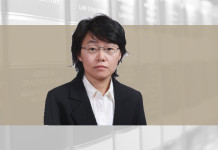Due to issues such as the standardization of some target companies, inability to be included into a listed company’s system, or issues with the listed company’s fund arrangements, it has become an approach widely used by listed companies that the controlling shareholder acquires the target company first and then the listed companies will acquire from the controlling shareholder when those issues are resolved. The controlling shareholder usually acquires the target company through setting up a fund, typically in the form of a limited partnership with a PE firm, bank, securities firm or other parties. Listed companies should focus on the following two issues when acquiring target companies.
Whether the acquisition constitutes a connected-party transaction. The essence in determining whether a connected-party transaction is constituted lies in whether the controlling shareholder controls, directly or indirectly, the M&A fund. In practice, the role that the controlling shareholder plays in the partnership, namely general partner (GP) or limited partner (LP), and the percentage of its capital contribution, will be considered. In addition, the controlling shareholder’s influence in the M&A fund’s decision making and the fund’s personnel arrangements are also important criteria for consideration.
In practice, the GP is generally considered to have control of the partnership. Therefore, if the controlling shareholder is the GP, or has a significant contribution in the GP, then it is considered to have control over the M&A fund as or through the GP. For example, in the industry M&A fund established by Suning Commerce Group, Dingyuan Investment, controlled by Suning Commerce Group’s controlling shareholder, Zhang Jindong, is the GP, while Suning Commerce Group, Suning Appliance and other investors are LPs. Unless there is evidence showing that Dingyuan Investment is unable to control the M&A fund, future acquisition of any of the fund’s portfolio companies by Suning Commerce Group should be deemed a connected-party transaction.
If the controlling shareholder has no control of the GP, then the percentage of its contribution in the LP will be considered. If the controlling shareholder or its associate’s share of capital contribution in the LP is not significant, then the controlling shareholder is not considered a connected party.
It needs to be noted, however, that in practice there are different standards for determining whether the controlling shareholder should be deemed a connected party in the event of an insignificant percentage of capital contribution. In Jincheng Pharmaceutical’s acquisition of 100% of Beijing Laneva Pharmaceutical, the controlling shareholder, Jincheng Industrial, had contributed 18.13% of the capital to the counterparty Jinsheng Fund before the purchase, and later transferred the interest to an independent third party.
Since Jincheng Industrial was a limited partner of Jinsheng Fund before the transfer of its interest, and this acquisition involved Jincheng Pharmaceutical, controlled by Jincheng Industrial, the independent financial adviser and legal counsel “deemed Jinsheng Fund a connected party of Jincheng Industrial before the transfer of interest, but not a connected party [that was] not controlled by Jinsheng Industrial, directly or indirectly, following the principle of ‘substance over form’.”
Generally, an M&A fund decision-making body is its investment committee. Therefore, if the controlling shareholder has quite a few seats on the investment committee, or the veto right, or if it assumes a key role in the GP, then it may also be deemed a connected party because of its control of, or significant influence over, the M&A fund.

Chief Partner
Grandway Law Offices
In conclusion, when acquiring a stake in a target company that is held by an M&A fund, the listed company should make its judgment by taking into account the contribution structure of the M&A fund’s GP and LPs, as well as the controlling shareholder’s influence on the fund’s investment decision making. The deal may be deemed to not constitute a connected-party transaction only if the controlling shareholder or its associate does not control the GP, or has no significant influence on its decision making, and that the controlling shareholder’s percentage of capital contribution in the LP is not significant.
Whether there are structured arrangements. The controlling shareholder may be required to make a structured arrangement for an M&A fund when it creates such a fund with other lenders (especially banks or private funds), to protect the return of the lenders. Under the arrangement, the lenders will hold preference shares in the M&A fund and enjoy a fixed return on investment, while the controlling shareholder holds inferior shares to provide a guarantee for the return on investment with preference shares.
In a deal in which a listed company purchases assets by issuing shares and directly involves an M&A fund as the opposing party, the M&A fund in a structured arrangement may, to a certain degree, affect the stability of the shareholding structure of the listed company. Therefore, it is especially required to consider whether to remove such a structured arrangement before the implementation of the deal.

Associate
Grandway Law Offices
Despite a prudent market attitude towards the involvement of structured funds in the purchase of listed companies’ shares, there are still some cases in which structured funds are approved to be a party of the transaction. For example, in Watertek Information’s acquisition of Tellhow Intelligent, the actual controllers of Watertek Information hold inferior shares in the Huida fund, which holds 21.68% equity in Tellhow Intelligent, and Xinyu Jingda, which holds 22.76% in Tellhow Intelligent, respectively. In the review process, the China Securities Regulatory Commission has placed its focus on whether the actual controllers have the ability to assume the liability for compensating the investors who hold preference shares in the target, and whether such compensation will affect the actual controllers’ control over the listed company.
At present, however, there are few cases in which structured funds are the targets of acquisition. In the cases that have been approved, structured funds always hold a smaller percentage of shares in the target company, and no multi-level structured arrangements exist. In the view of the authors, for purchase of assets by issuing shares with an M&A fund under structured arrangement, if the fund holds a smaller percentage of shares in the target, such an M&A fund can be taken for direct acquisition on a reasonable and prudent basis only after getting it clear that there exists no multi-level arrangement for the fund, that the partners holding inferior shares have the corresponding solvency, and that the solvency guarantee will not affect the stability of the listed company’s shareholding structure.
Zhang Liguo is the chief partner and Zhang Ying is an associate at Grandway Law Offices
北京市东城区建国门内大街26号
新闻大厦7层 邮编:100005
7/F, Beijing News Plaza
No. 26 Jianguomennei Dajie
Beijing 100005, China
电话 Tel: +86 10 8800 4488 / 6609 0088
传真 Fax: +86 10 6609 0016
电子信箱 E-mail:
zhangliguo@grandwaylaw.com
zhangying@grandwaylaw.com
www.grandwaylaw.com






















